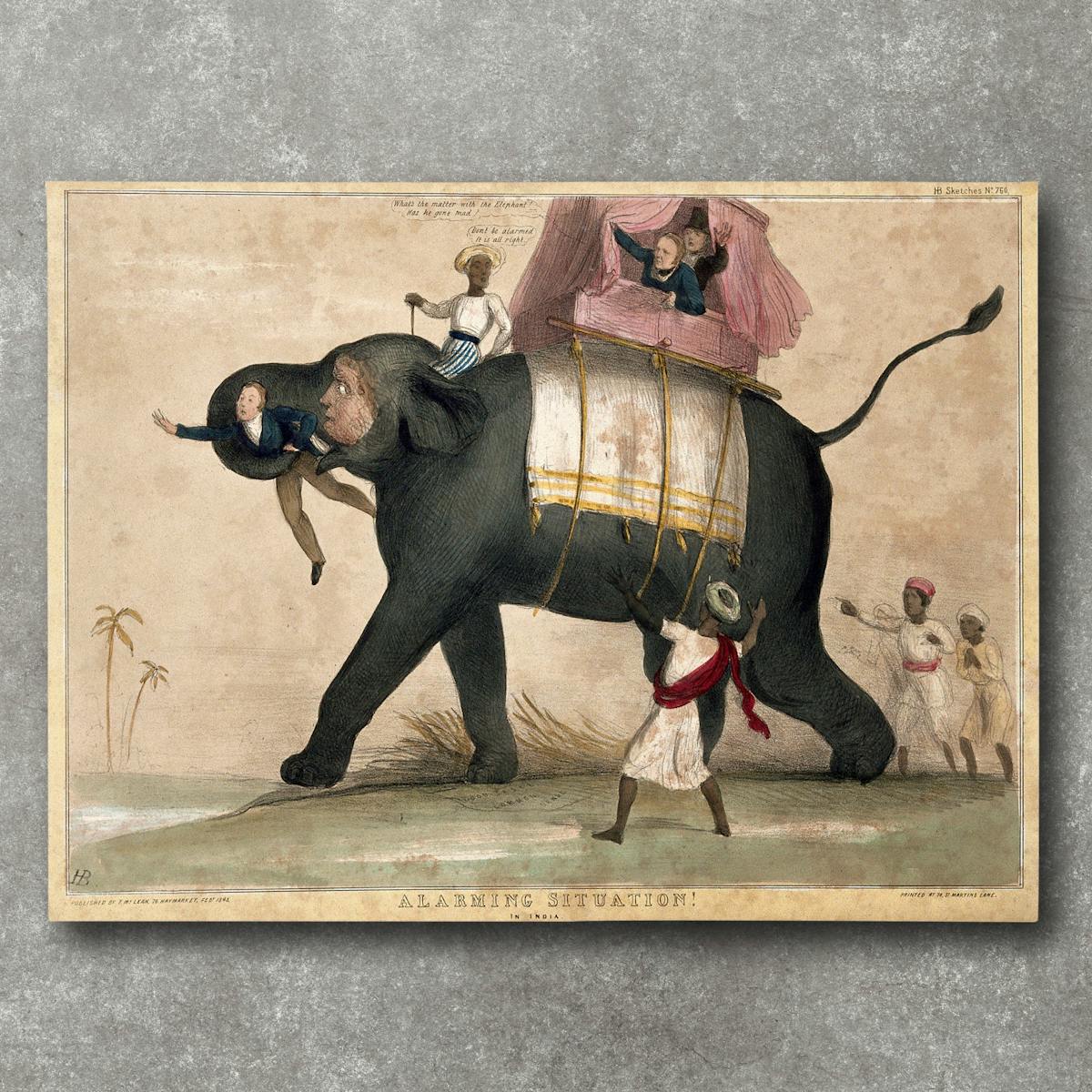The nature and form of scientific experiments can tell you as much about the researcher as the test subject. When Thomas Parkinson investigated the visual tests and treatments used by neurologists in the early days of “speech science”, he discovered an unexpected link between empire, elephants and aphasia.
Aphasia and drawing elephants
Words by Thomas Parkinsonaverage reading time 7 minutes
- Article
Disorders of the voice have always been culturally significant. Different kinds of speech impairments, such as stammering, verbal apraxia and muteness, have been treated as subjects of curiosity and ridicule. Towards the end of the 19th century, during a formative era in “speech science”, one particular impairment – aphasia – seemed to capture Victorian minds more than any other.
Modern definitions of aphasia – a loss of power to understand written or spoken language – belie its complex, unruly history. Parisian doctors like Pierre Paul Broca (1824–80) drew attention to aphasia by showing how it revealed critical information about the functions of the brain. Broca observed linguistic behaviours in patients with brain damage, and from their corresponding injuries he was able to identify and ‘localise’ the regions of the brain responsible for producing speech.
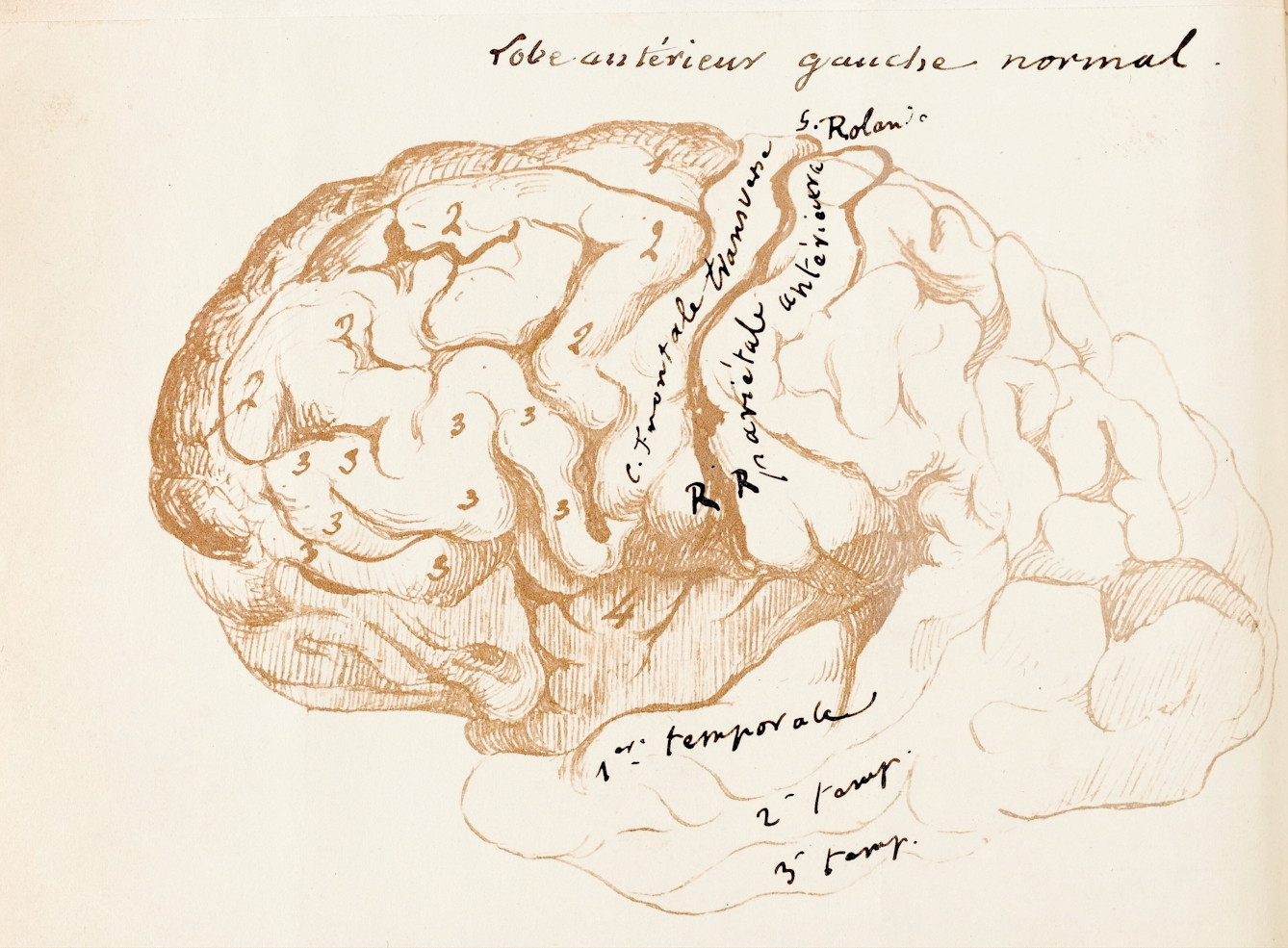
Illustration from the book ‘Observations d’aphémie [Observations of aphasia]‘ (1864) by Ange Duval. The French text is based on the work of Pierre Paul Broca.
In the wake of Broca’s seismic discovery, clinical literature on aphasia burgeoned in Europe and across parts of the world that had seen the introduction of Western, or colonial, medicine. During that initial chapter of ‘aphasiology’, the interests of disabled speakers were marginalised by physicians, who were more concerned with tackling profound neurological questions than with accommodating or rehabilitating their patients.
Doctors provided opportunities for individuals with aphasia to communicate non-verbally, but only through their participation in a series of neurological tests. Because aphasia was associated with a host of other neurological symptoms, practitioners encouraged their patients to execute supposedly routine tasks, such as reading, performing arithmetic, writing and drawing.
Aphasia art
Visual representation continues to play a significant role in speech and language therapy today, especially for individuals recovering from stroke, and for those with impairments like aphasia. The benefits of art therapy for people with aphasia have been backed by research that has sought to highlight how painting and drawing restores a patient’s selfhood and agency. “A picture is worth a thousand words,” advocates claim.
But more critical reflections upon its history reveal that “aphasia art” was not simply a method of rehabilitation. “Speech scientists” of the 19th century integrated patient drawings into their practice to test, rather than to rehabilitate speakers.
Experimentation with the artistic capacities of people with aphasia depended upon, and were constructed around, a patient’s background, experience and expertise. Armand Trousseau (1801–67), who popularised the term ‘aphasia’, noted that one of his patients was a painter and student of the notable French landscape artist, Jules Coignet.
In Britain, at least, the elephant was an ‘exotic’ Indian animal associated with colonial pageantry, adventurism and conflict in far-flung territories ruled by the Crown.
Asked to draw a shepherdess, a motif of French pastoral figure-painting, the man “[sketched] a grotesque human head”. “The truth,” Trousseau concluded, “is that his fingers obey an automatic impulse, to which thought remains a complete stranger.”
Patients’ line drawings, to those who studied them, seemed to embody the tragedy of creative loss and intellectual inhibition. This sense of tragic deficiency was reinforced by the prevailing negative light in which neurological and “mental disorder” was cast.
Yet even when patients were unequipped with artistic skill, their desire to communicate by drawing was undiminished. British doctor Arthur F Hurst (1879–1944) noted of a brain-damaged war veteran how “the part played by drawing in his recovery [was] particularly remarkable, as he had never been interested in drawing before he lost his speech”.
Drawing elephants
In his book ‘Aphasia and Kindred Disorders of Speech’, English neurologist Henry Head (1861–1940) reflected that “the capacity to draw forms one of the most interesting means we possess for investigating the defects of function”. The mechanical act of drawing was, in and of itself, uninteresting to the speech scientists of the era. But how that process served to ‘translate’ an unutterable idea or meaning was, according to them, a point of fascination.
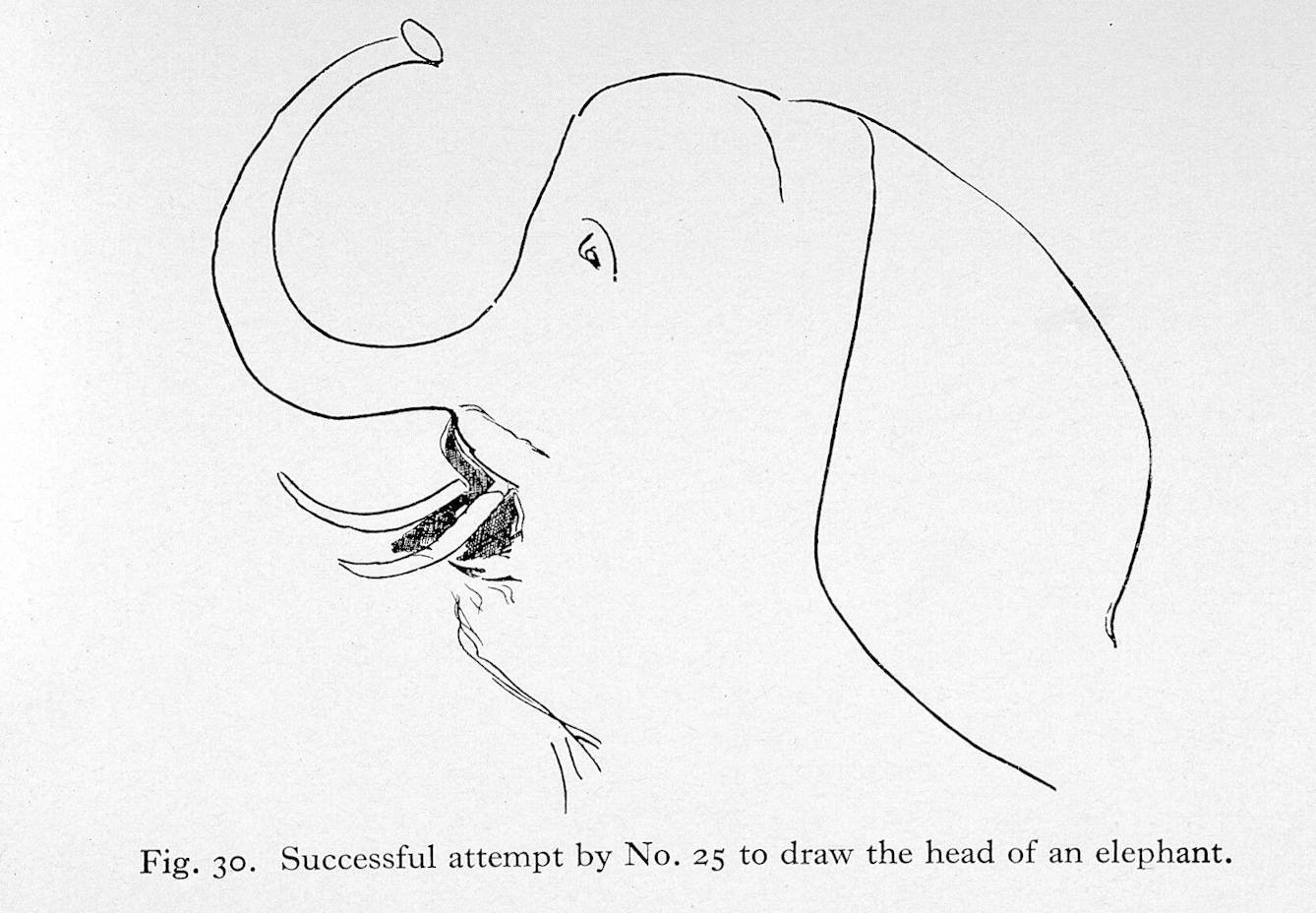
Patient No. 25 is “Miss A.C.S., born 1867” and a professional gardener. She first saw Henry Head in 1910 because no one had been able to explain the “mental clumsiness from which she had suffered all her life”. Head noted that “in spite of her disabiities, she was unusually intelligent”.
Head standardised his “art experiments” by asking each of his patients to depict an elephant, an animal that was revered in British culture for its exoticism and imperial connotations. Earlier case studies on aphasia, including those by Broca, had used an image of an elephant as an example of how patients resorted to drawing when they struggled to speak (“le malade a voulu dessiner un éléphant”, i.e., the patient wanted to draw an elephant). Evidently there was something about the visuality and symbolism of the trunked mammal that made it unique.
The colonial significance of elephants
In Britain, at least, the elephant was an ‘exotic’ Indian animal associated with colonial pageantry, adventurism and conflict in far-flung territories ruled by the Crown. For precisely that reason, the elephant was particularly well suited to Head’s battery of aphasiological tests:
“The shape of the body is so characteristic, and the trunk and tusks cannot be omitted even by the most unobservant normal individual [sic],” he remarked. The peculiarity of aphasia, according to the logic of English neurologists, coincided with the peculiarity of the elephant and its strange, alien anatomy.
A number of Head’s patients who had received injuries in combat were “imperial cosmopolitans” who had roamed the lands of the British Empire for pleasure, to rule, and “to serve”. Head himself was a part of an elite, colonial, British class of scientists and academics.
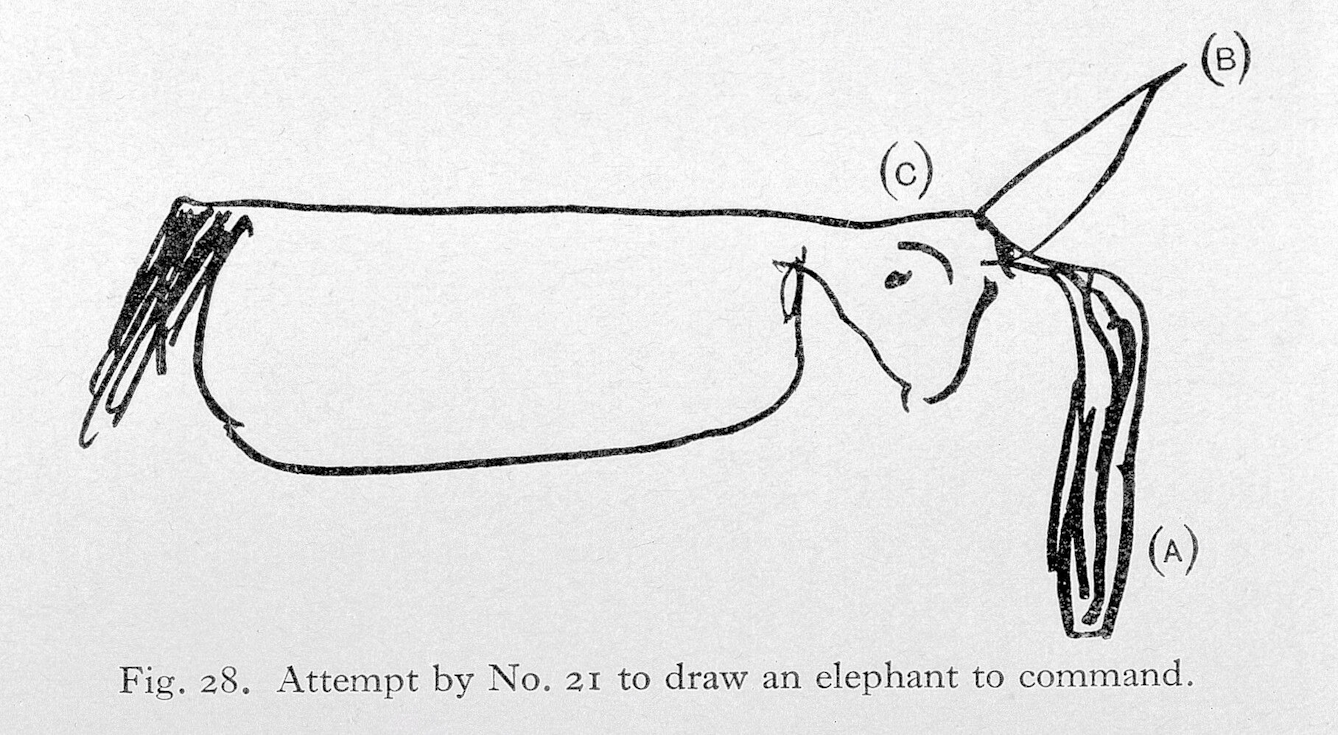
Patient No. 21 was “John B., born 1855”. He was admitted to hospital in 1911 with “a case of severe Aphasia, due to a vascular lesion in an elderly man”. John worked “as a steward on a boat travelling between India and China and had brought home some carved figures of elephants”.
The physician admitted that these patients had possessed the capacity to sketch the elephant only because of their colonial experiences. And what they knew about the elephant’s shape and size seemed to be derived “not only from visits to the Zoological Gardens, but owing to military service in India, or voyages to that country”.
While their knowledge of the animal was measured against the accuracy of their depictions, some still “omitted the trunk” or added superfluous features like hair, horns, and a “bushy tail”. Patient No. 10 produced an outline of the animal that could hardly be made out, while No. 21 – who had bought an elephant figurine in India – sketched a distorted version of the iconic creature.
Patient No. 2, a military captain who had been kicked in the head by a horse, failed to draw an elephant, which came as a surprise to Head because of the man’s predilection for art, and his passion for “making pictures of the animals he had shot in Cashmir [sic]”. Injured in Mesopotamia in February 1918, Patient No. 2 was transported to a colonial hospital in Bombay to recover. When his illustrative attempt at an elephant unravelled, he made a “spirited picture of a camel” instead.
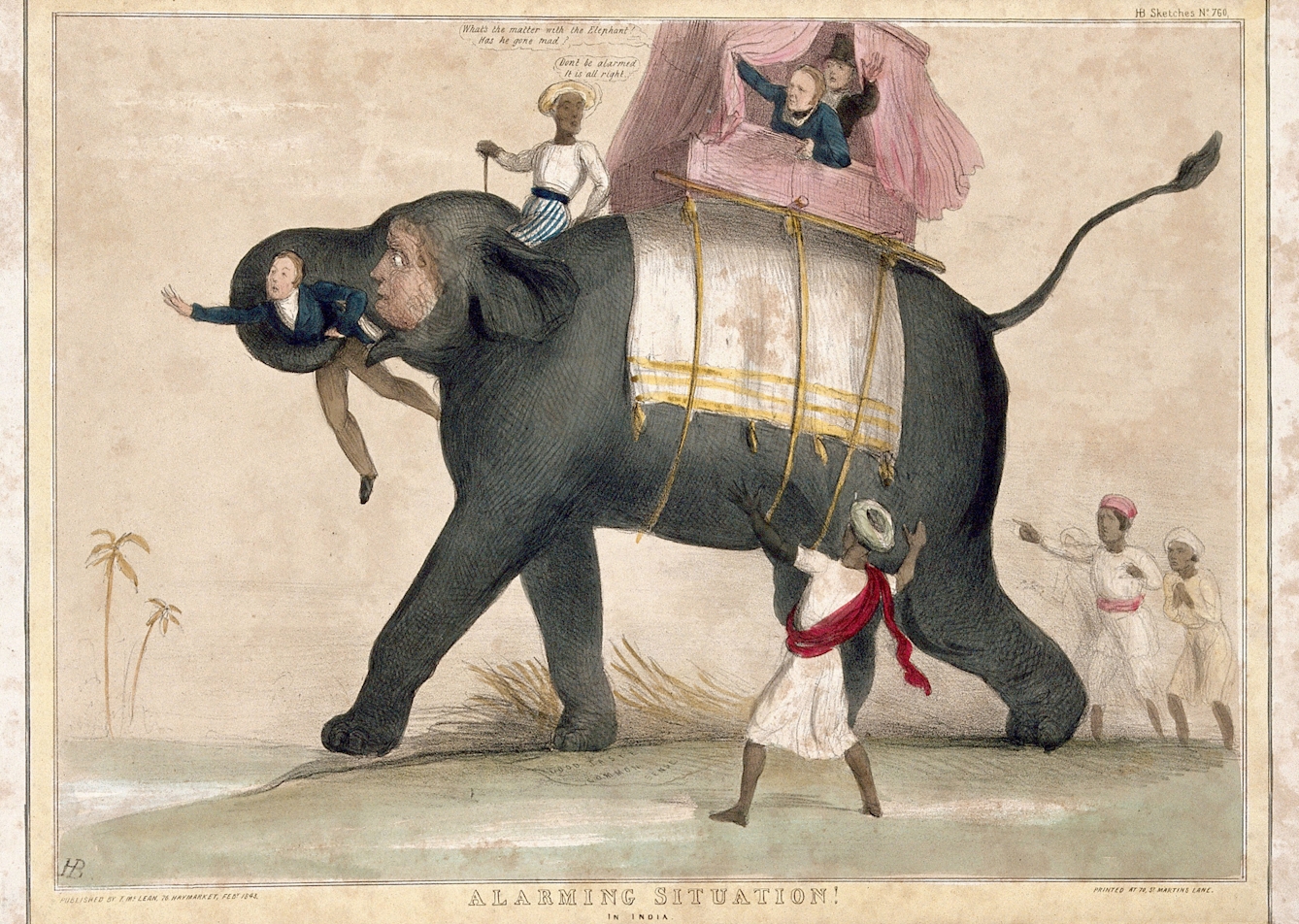
The elephant represents the Governor-General of India, Lord Ellenborough, who was strongly criticised for his accusations against his predecessor, Lord Auckland. The print is based on a painting by the celebrated artist Johann Zoffany, in which Indian dignitaries paid court to a previous Governor-General of India.
The elephant – the quintessence of animal orientalism – was a “representation of the colonial world” that signalled imperial conquest, not only of Africa and Asia, but of nature itself. Over time, the elephant was incorporated into an imperial imagery, and it became synonymous with British rule in the Indian subcontinent.
While aphasia art may offer some benefits for patients today, its history was one that was bound up with the experimental dispositions of medical men, and the colonial cultures surrounding them and their patients. Instead of being a neutral, therapeutic tool, aphasia art could reflect deeper, troubling political realities which, in Britain, have tended to be relegated to our collective subconscious.
The visual history of neurology reveals the relationship between elephants, empire and aphasia art, and suggests that a picture can indeed be worth a thousand words.
About the author
Thomas Parkinson
Thomas Parkinson is a PhD student at the University of Cambridge. His doctoral project presents a cultural history of speech impairment in colonial India, and he is interested in the colonial roots of speech science and medicine.
